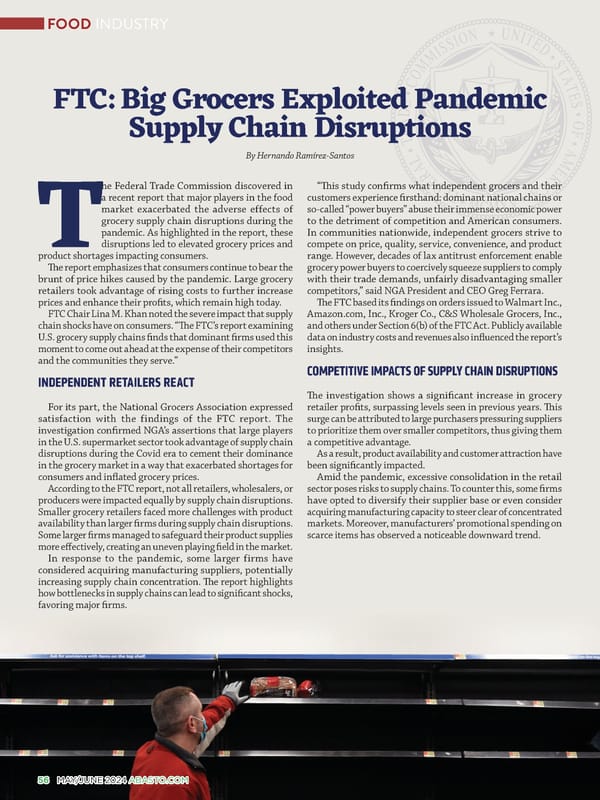FOOD INDUSTRY FTC: Big Grocers Exploited Pandemic Supply Chain Disruptions By Hernando Ramírez-Santos he Federal Trade Commission discovered in “吀栀is study con昀椀rms what independent grocers and their a recent report that major players in the food customers experience 昀椀rsthand: dominant national chains or market exacerbated the adverse effects of so-called “power buyers” abuse their immense economic power grocery supply chain disruptions during the to the detriment of competition and American consumers. pandemic. As highlighted in the report, these In communities nationwide, independent grocers strive to Tdisruptions led to elevated grocery prices and compete on price, quality, service, convenience, and product product shortages impacting consumers. range. However, decades of lax antitrust enforcement enable 吀栀e report emphasizes that consumers continue to bear the grocery power buyers to coercively squeeze suppliers to comply brunt of price hikes caused by the pandemic. Large grocery with their trade demands, unfairly disadvantaging smaller retailers took advantage of rising costs to further increase competitors,” said NGA President and CEO Greg Ferrara. prices and enhance their pro昀椀ts, which remain high today. 吀栀e FTC based its 昀椀ndings on orders issued to Walmart Inc., FTC Chair Lina M. Khan noted the severe impact that supply Amazon.com, Inc., Kroger Co., C&S Wholesale Grocers, Inc., chain shocks have on consumers. “吀栀e FTC’s report examining and others under Section 6(b) of the FTC Act. Publicly available U.S. grocery supply chains 昀椀nds that dominant 昀椀rms used this data on industry costs and revenues also in昀氀uenced the report’s moment to come out ahead at the expense of their competitors insights. and the communities they serve.” COMPETITIVE IMPACTS OF SUPPLY CHAIN DISRUPTIONS INDEPENDENT RETAILERS REACT 吀栀e investigation shows a signi昀椀cant increase in grocery For its part, the National Grocers Association expressed retailer pro昀椀ts, surpassing levels seen in previous years. 吀栀is satisfaction with the findings of the FTC report. The surge can be attributed to large purchasers pressuring suppliers investigation con昀椀rmed NGA’s assertions that large players to prioritize them over smaller competitors, thus giving them in the U.S. supermarket sector took advantage of supply chain a competitive advantage. disruptions during the Covid era to cement their dominance As a result, product availability and customer attraction have in the grocery market in a way that exacerbated shortages for been signi昀椀cantly impacted. consumers and in昀氀ated grocery prices. Amid the pandemic, excessive consolidation in the retail According to the FTC report, not all retailers, wholesalers, or sector poses risks to supply chains. To counter this, some 昀椀rms producers were impacted equally by supply chain disruptions. have opted to diversify their supplier base or even consider Smaller grocery retailers faced more challenges with product acquiring manufacturing capacity to steer clear of concentrated availability than larger 昀椀rms during supply chain disruptions. markets. Moreover, manufacturers’ promotional spending on Some larger 昀椀rms managed to safeguard their product supplies scarce items has observed a noticeable downward trend. more e昀昀ectively, creating an uneven playing 昀椀eld in the market. In response to the pandemic, some larger firms have considered acquiring manufacturing suppliers, potentially increasing supply chain concentration. 吀栀e report highlights how bottlenecks in supply chains can lead to signi昀椀cant shocks, favoring major 昀椀rms. 5656 MMAAYY//JJUUNNE 2E 200224 4 AABBAASSTOTO..CCOOMM
 Abasto Magazine - May/June 2024 Page 103 Page 105
Abasto Magazine - May/June 2024 Page 103 Page 105